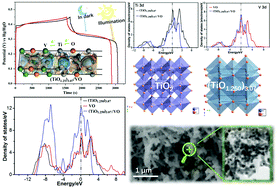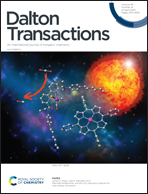P-Functionalized and O-deficient TiOn/VOm nanoparticles grown on Ni foam as an electrode for supercapacitors: epitaxial grown heterojunction and visible-light-driven photoresponse†
Abstract
P–TiOn–VOm nanowires were grown on nickel foam (NF) via a one-pot hydrothermal method and by further vapor deposition/phosphorization method. It was found that low valence states of titanium oxide and deficient-oxygen coexist in P–TiOn–VOm/NF. Furthermore, (TiO1.25)3.07 (denoted as TiOn) and VO (denoted as VOm) possess similar structures and matched facets, and their epitaxial growth leads to the formation of TiOn/VOm heterostructure with a formation energy of −1.59 eV. P–TiOn–VOm/NF possesses good electron conductivity and electrons can be transferred from Ti to V centers, as evidenced by the DFT calculations and the XPS spectra. As a result, the specific capacity of P–TiOn–VOm/NF can reach 785 C g−1 at 1 A g−1 in the potential range of 0–0.55 V vs. Hg/HgO, which is much larger than those of VOm/NF, P–VOm/NF, and P–TiO2–VOm/NF. On the other hand, the TiOn/VOm heterostructure also favors the separation and transfer of photoinduced electrons and holes, and P–TiOn–VOm/NF exhibits visible-light-driven photoresponse. Under visible light illumination, the specific capacity of P–TiOn–VOm/NF is increased by 6.2% relative to that in the dark. Furthermore, the P–TiOn–VOm/NF//activated carbon (AC) asymmetric supercapacitor (ASC) shows an energy density of 37.2 W h kg−1 at a power density of 1 kW kg−1 and excellent cycling performance with 93.6% capacity retention after 10 000 cycles at 5 A g−1, which is comparable to and even superior to those of titanium oxides and vanadium oxides. A promising achievement has been proposed to improve the energy storage performance of P–TiOn–VOm through P-functionalization and O-deficiency in this work.



 Please wait while we load your content...
Please wait while we load your content...